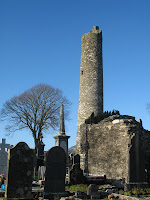One of the differences between Ireland and New Zealand is the evidence of history going back 1000's of years in ruins, buildings and at heritage sites just about everywhere you look. Evidence of New Zealand's relatively recent past seems almost like yesterday in comparison to the story of Ireland.
On our way back from Carlingford Edu, Lydia, Glynn and I stopped at Monisterboice and Mellifont Abbey - two monastic sites dated around 900 and 1000 AD.
 |  |
The round tower and high crosses we found at Monasterboice are similar to those found throughout Ireland. Monks would run up into the round towers and pull up the rope stairs behind them to protect themselves as the vikings approached.
 |  |
The hexagonal shaped lavabo at Mellifont Abbey, shown in the photos and link above, is now only remnants of an area where monks washed their hands before meals. It is the only ruin of its kind in the world, and it must also set the record for being (in its day) one of the largest wash basins on the planet.
We travelled further down the old irish back roads following the River Boyne to the 5000 year old neolithic passage tomb at Newgrange. Newgrange is a well-organised commercial operation, but it still doesn't take away from the surreal atmosphere of the place. Used as a tomb for cremated remains, a passageway leads to a small chamber and both are covered by a large mound of stone and earth which blends into the crest of the hill. The neolithic artisans had a good grasp of astronomy, for like many passage tombs around Europe it aligns with the sun on a certain day of the year. Newgrange however is famous for being one of the oldest passage tombs and is now designated as a World Heritage Site.
 |  |
On December 21st (the shortest day of the year in the northern hemisphere) at around 9am for 17 minutes a beam of light shines down the passageway through a roof box at the entrance, lighting up the inner chamber. Tickets to the event every year can't be obtained by an average kiwi girl like me (even with an irish boyfriend) and only VIPs, dignitaries and politicians ever get to see the actual event nowadays. The chamber itself is small and only held our tour group 17 at a time. While archaeologists and historians don't actually know what this lighting of the chamber meant to the neolithic people, we do know that the roof still doesn't leak after 5000 years - so they were smart, practical people who could probably teach a kiwi builder a thing or two. Newgrange was accessed in 1699 when the tombs were raided and many of the bodies and artefacts were stolen. When it was properly excavated in 1962 only five bodies remained and a good amount of graffiti circa 18th Century.

It was fun to be able to go there with Glynn's sister Lyd and boyfriend Edu, and it was another opportunity for me to get to know them better before they left to return home to Spain the next day. Glynn and I enjoyed the tour, especially when they dimmed the lights in the passageway and simulated the sun entering the chamber albeit with a 40 watt bulb. The tour guide's voice was sufficiently spooky to make the hairs stand on the back of the neck (a little bit). It was late in the day when we visited and with the sun setting low in the sky as we left we got a feel for the winter solstice on the 21st.
 |  |
It's pretty wild to realise that globally we all probably share in the ancestry of the original Newgrange people - and while we can all celebrate how far we've come since our neolithic ancestors were walking the planet, there is no way that Glynn's flat will still be standing in 7006. There's probably a lot more we could learn from the neolithic people than just how to put on a good roof.


1 comment:
That whole leaky roof thing isn't a subtle dig at 39 fendalton right? ;)
Great to see you're getting to see the sights... Newgrange is certainly one of my favourites.
Post a Comment